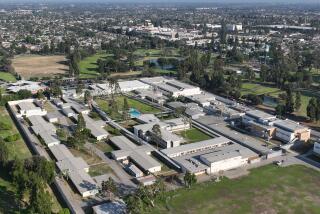Judges indicate they may order prison population reduced by 58,000
- Share via
SACRAMENTO — A panel of three federal judges, saying overcrowding in state prisons has deprived inmates of their right to adequate healthcare, tentatively ruled Monday that the state must reduce the population in those lockups by as many as 57,000 people.
The judges issued the decision after a trial in two long-running cases brought by inmates to protest the state of medical and mental healthcare in the prisons.
Although their order is not final, U.S. District Court Judges Thelton Henderson and Lawrence Karlton and 9th U.S. Circuit Court of Appeals Judge Stephen Reinhardt effectively told the state that it had lost the trial and would have to make dramatic changes in its prisons unless it could reach a settlement with inmates’ lawyers.
State officials immediately said they would appeal.
If the state is ordered to reduce the prison population, it would likely be able to do so over two or three years, so it would not have to release large numbers of inmates at once. Some methods of cutting the population include limiting new admissions, changing policies so parole violators return to prison less frequently, and giving prisoners more time off of their sentences for good behavior and rehabilitation efforts.
The judges said these types of measures could save the state more than $900 million a year in prison costs, money that could be used by cities and counties to put those who otherwise would have gone to prison into local jails or treatment programs.
The state’s 33 prisons were designed for 84,000 inmates, and they now hold 158,000, nearly double their designed capacity. The rest of the 170,000 in the correctional system are in out-of-state prisons and other facilities. The judges found that with inmates crammed into institutions, they could not receive the care to which they are entitled under the U.S. Constitution.
“There is . . . uncontroverted evidence that, because of overcrowding, there are not enough clinical facilities or resources to accommodate inmates with medical or mental health needs at the level of care they require,” the judges wrote in a 10-page decision.
They said that triple-bunking of inmates in prison gymnasiums has increased the risk of infectious disease and that a shortage of doctors, nurses and correctional officers has denied inmates access to treatment and a decent system to keep their medical records in order.
In the ruling, the judges said they believe the state’s prisons can safely operate at 120% to 145% of their designed capacity. Based on the current prison population, that would mean a potential reduction of 36,000 to 57,000 inmates. They reserved the right to change their numbers and did not say when their final order might come.
“It’s a pretty comprehensive victory for us,” said Michael Bien, a lawyer in San Francisco who has fought for mentally ill prisoners. “It was a message -- a very loud, clear message -- that it’s time that the public officials in California took responsibility for their own criminal justice system.”
Under federal law, judges cannot order the state to lock up fewer prisoners if such a move would endanger the public, and the panel said that would not be the case if reductions were done gradually.
But Matt Cate, Gov. Arnold Schwarzenegger’s corrections secretary, said the ruling “poses a significant threat to public safety” because it could prevent the state from incarcerating as many criminals as it now keeps in seven to 10 prisons.
“If this panel issues a final decision, we will appeal this matter to the United States Supreme Court,” Cate said tersely during a news conference in Sacramento.
State Atty. Gen. Jerry Brown called the ruling “the latest intrusion” on California’s prison system by the federal courts. In a statement, he labeled the order “a blunt instrument that does not recognize the imperatives of public safety, nor the challenges of incarcerating criminals, many of whom are deeply disturbed.”
The judges oversaw the trial starting in November and completed it last week. In their decision, they referred to the testimony of Jeanne Woodford, a former corrections secretary under Schwarzenegger, who told them overcrowding made it impossible for prisoners to get mental health treatment and medical exams. They also cited experts from Texas, Pennsylvania, Maine and Washington.
And the judges used Schwarzenegger’s words and actions against him, citing the state of emergency the governor declared for the prisons in 2006 -- still in effect -- and quoting him as saying overcrowding had caused “substantial risk to the health and safety” of prison inmates and staff. They noted that Schwarzenegger has made budget-related proposals to reduce the prison population by 40,000 inmates, and that lawmakers have backed similar ideas.
“We cannot believe that such support would exist if the adoption of such measures would adversely affect public safety,” the judges wrote, although the proposals they referred to have not garnered enough support to go into effect.
The state nearly reached a settlement with the inmates last year that would have reduced the prison population by tens of thousands, largely by shifting low-level offenders to local jails and rehabilitation programs. But that deal fell apart when Republican state lawmakers and county prosecutors objected.
Since then, the state has hardened its stance. Schwarzenegger and Brown are now demanding that Henderson terminate court oversight of prison medical care, which he seized from the state in 2006. They say the situation has improved with the hiring of new medical and correctional personnel.
--
More to Read
Sign up for Essential California
The most important California stories and recommendations in your inbox every morning.
You may occasionally receive promotional content from the Los Angeles Times.













